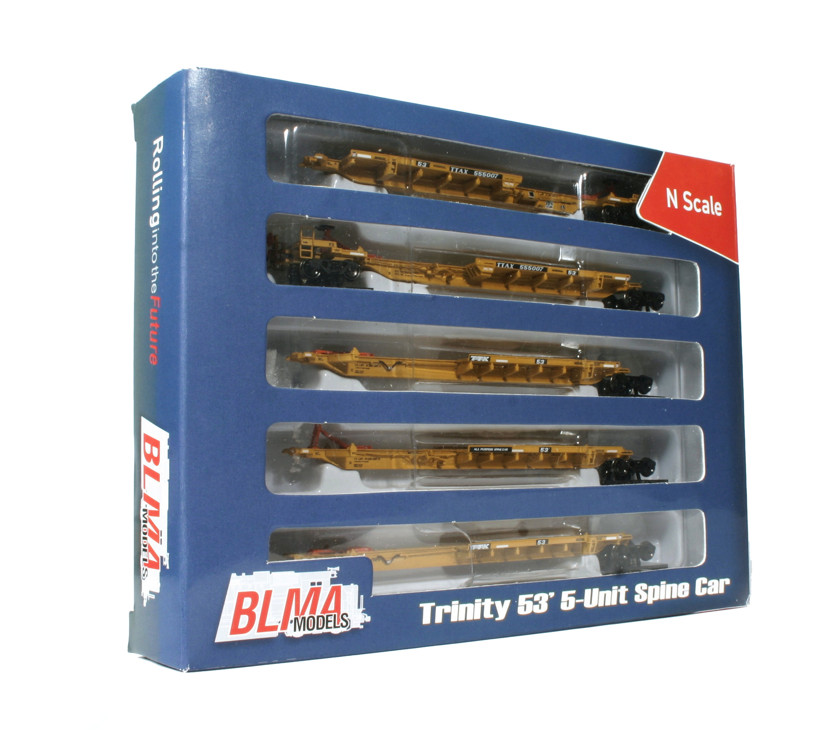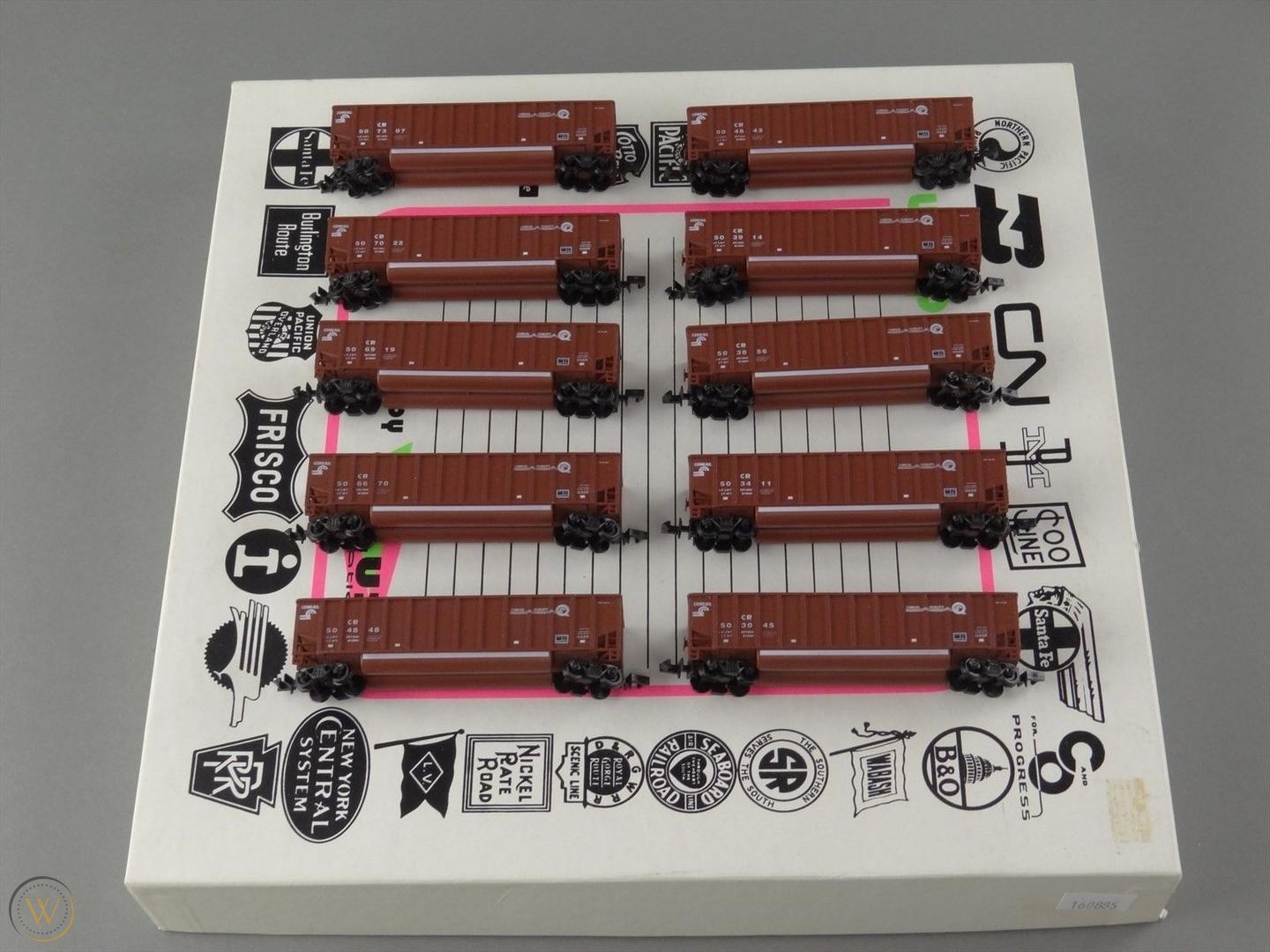Specific Item Information: Stock number used for two different items (CFX and GBW).
Model Information: This model was first produced by Kadee in February of 1981. It is a model of a 50 Foot Steel Rib-Side Single Sliding Door Boxcar. Specifically, this Micro-Trains body style models the FMC 50' 5077 Single Sliding Door prototype. It is also used by Micro-Trains to model Pullman Standard 50' boxcars. Hence on some releases, this car is labeled as a Pullman Standard and in other cases it is labeled as an FMC boxcar, and it also is frequently labeled as a '50' Rib Side Box Car[sic]' with no mention of prototype whatsoever. It appears to be closest to the FMC 5077 boxcar prototype (from the 1970s) in any event. These models can appear with any one of multiple different sliding door types. The doors for this model are operating ones (cool!).
Prototype History: In the 1970's with the growth of the Per Diem business model, FMC produced a series of 50 foot box cars in different configurations. The single-sliding-door configuration is one of the best known and used widely by many different railroads. These cars were produced using the Gunderson metal works which FMC had acquired in 1965. In late 1975, FMC began producing a 5,077-cubic-foot Plate B box car for IPD and Railbox service. FMC's 5077s have seven panels to either side of the 10-foot door, an X-panel roof, and non-terminating ends that are slightly different from those used on FMC's earlier cars. Note how the sidesill is notched all the way back to the bolsters, a key feature of FMC's mature design.
The main difference between the 5077 cu. ft cars built by FMC vs the 5277-5347 cu. ft cars built by the same manufacturers is the overall height of the car, the smaller 5077 cars were Plate B while the larger 5277-5347 cars were Plate C. Over 4,300 cars were produced from 1975-1979 by FMC's Portland, Oregon plant. The cars were delivered in numerous colorful shortline paint schemes, as well as the nationwide car pool fleet of Railbox. Many secondhand cars were later seen in Class 1 railroads and large leasing company fleets under additional shortline reporting marks.
The main difference between the 5077 cu. ft cars built by FMC vs the 5277-5347 cu. ft cars built by the same manufacturers is the overall height of the car, the smaller 5077 cars were Plate B while the larger 5277-5347 cars were Plate C. Over 4,300 cars were produced from 1975-1979 by FMC's Portland, Oregon plant. The cars were delivered in numerous colorful shortline paint schemes, as well as the nationwide car pool fleet of Railbox. Many secondhand cars were later seen in Class 1 railroads and large leasing company fleets under additional shortline reporting marks.
Road Name History: The GB&W was the result of the 1896 reorganization of earlier companies connecting Green Bay, Wisconsin with the Mississippi River port of Winona, Minnesota. The line east from Green Bay to the car ferry port at Kewaunee was built as the affiliated Kewaunee Green Bay & Western. It wasn’t completely merged into GB&W until 1969. The 277 mile combined line bisected the state of Wisconsin. Railroad car ferries connected Kewaunee with the Ann Arbor, GTW, and C&O in Michigan’s lower peninsula. For a number of years, another subsidiary the Ahnapee & Western was operated as part of the GB&W but was sold to new owners in 1947.
Light rails and bridges put the GB&W about 20 years behind other railroads in steam technology. For instance, they were still receiving new 2-8-0’s in the late 20s. The biggest engines in the fleet were a half dozen light Mikados which arrived in 1937 and ’39.
In 1929, they established the Western Refrigerator Line to manage a 500 car fleet of reefers (presumably to serve the many packers of Green Bay.) Passenger service was always a low priority and ended entirely in 1941.
By 1950, they had completely dieselized, entirely with Alcos. For the second generation of diesels, GB&W concentrated on C424’s. Typically, there were 18-20 units on the roster at any one time. They would remain all-Alco to the end with first generation units set up to run long hood forward and second generation running short hood forward.
The bridge traffic created by the car ferry link to Michigan included high value auto parts. However, in the late 70’s, the car ferry traffic plummeted and GB&W began relying on paper industry traffic generated on line. In 1978 the line was purchased by Itel (yes, the per diem boxcar people.) Finally in 1993, the Green Bay & Western was merged into a subsidiary of Wisconsin Central.
Light rails and bridges put the GB&W about 20 years behind other railroads in steam technology. For instance, they were still receiving new 2-8-0’s in the late 20s. The biggest engines in the fleet were a half dozen light Mikados which arrived in 1937 and ’39.
In 1929, they established the Western Refrigerator Line to manage a 500 car fleet of reefers (presumably to serve the many packers of Green Bay.) Passenger service was always a low priority and ended entirely in 1941.
By 1950, they had completely dieselized, entirely with Alcos. For the second generation of diesels, GB&W concentrated on C424’s. Typically, there were 18-20 units on the roster at any one time. They would remain all-Alco to the end with first generation units set up to run long hood forward and second generation running short hood forward.
The bridge traffic created by the car ferry link to Michigan included high value auto parts. However, in the late 70’s, the car ferry traffic plummeted and GB&W began relying on paper industry traffic generated on line. In 1978 the line was purchased by Itel (yes, the per diem boxcar people.) Finally in 1993, the Green Bay & Western was merged into a subsidiary of Wisconsin Central.
Brand/Importer Information: The Freight Yard was a hobby shop that did custom decoration and special runs of other manufacturers' N Scale products. It sold its custom products under several brands or collections: Premiere Editions, by The Freight Yard and Dreams Design.
It was located in Anaheim, California and then moved to 2006 in Phoenix, Arizona.
Established in the late 1980s, it stopped business under this name by the end of the 2000s.
The Freight Yard was owned and operated by Darren J. Cohen. Darren is now operating North Valley Trains.
The Freight Yard / Premiere Editions runs are usually available in series of two to twelve different numbers (suffixed A to M, with I not used).
The first two digits of the stock number correspond to the release year (9x being 199x, and 2x being 200x).
It was located in Anaheim, California and then moved to 2006 in Phoenix, Arizona.
Established in the late 1980s, it stopped business under this name by the end of the 2000s.
The Freight Yard was owned and operated by Darren J. Cohen. Darren is now operating North Valley Trains.
The Freight Yard / Premiere Editions runs are usually available in series of two to twelve different numbers (suffixed A to M, with I not used).
The first two digits of the stock number correspond to the release year (9x being 199x, and 2x being 200x).
Manufacturer Information:  Micro-Trains Line split off from Kadee Quality Products in 1990. Kadee Quality Products originally got involved in N-Scale by producing a scaled-down version of their successful HO Magne-Matic knuckle coupler system. This coupler was superior to the ubiquitous 'Rapido' style coupler due to two primary factors: superior realistic appearance and the ability to automatically uncouple when stopped over a magnet embedded in a section of track. The success of these couplers in N-Scale quickly translated to the production of trucks, wheels and in 1972 a release of ready-to-run box cars.
Micro-Trains Line split off from Kadee Quality Products in 1990. Kadee Quality Products originally got involved in N-Scale by producing a scaled-down version of their successful HO Magne-Matic knuckle coupler system. This coupler was superior to the ubiquitous 'Rapido' style coupler due to two primary factors: superior realistic appearance and the ability to automatically uncouple when stopped over a magnet embedded in a section of track. The success of these couplers in N-Scale quickly translated to the production of trucks, wheels and in 1972 a release of ready-to-run box cars.
Micro-Trains Line Co. split off from Kadee in 1990 to form a completely independent company. For this reason, products from this company can appear with labels from both enterprises. Due to the nature of production idiosyncrasies and various random factors, the rolling stock from Micro-Trains can have all sorts of interesting variations in both their packaging as well as the products themselves. When acquiring an MTL product it is very important to understand these important production variations that can greatly enhance (or decrease) the value of your purchase.
Please consult our Micro-Trains Collector's Guide

Micro-Trains Line Co. split off from Kadee in 1990 to form a completely independent company. For this reason, products from this company can appear with labels from both enterprises. Due to the nature of production idiosyncrasies and various random factors, the rolling stock from Micro-Trains can have all sorts of interesting variations in both their packaging as well as the products themselves. When acquiring an MTL product it is very important to understand these important production variations that can greatly enhance (or decrease) the value of your purchase.
Please consult our Micro-Trains Collector's Guide
Item created by: Alain LM on 2022-05-16 01:41:52. Last edited by Alain LM on 2022-09-25 09:17:48
If you see errors or missing data in this entry, please feel free to log in and edit it. Anyone with a Gmail account can log in instantly.
If you see errors or missing data in this entry, please feel free to log in and edit it. Anyone with a Gmail account can log in instantly.











